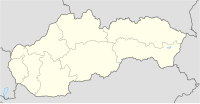Ostrý Kameň Castle
| Ostrý Kameň Castle | |
|---|---|
| Buková, Slovakia | |

View on the castle ruins from Záruby.
|
|
| Coordinates | 48°31′19″N 17°22′16″E / 48.521858°N 17.371110°E |
| Site information | |
| Condition | Ruined |
| Site history | |
| Built | 13th century |
| Materials | Limestone |
| Demolished | 18th century |
Ostrý Kameň Castle (German: Scharfenstein; Hungarian: Élskö) is a ruined castle in the municipality of Buková in the Trnava region of Slovakia.
The castle was first mentioned in 1273. Although the origins of the Ostrý Kameň castle are not clear, it is believed that it was built in the 13th century. The goal of building this royal border fort on the western border of the Hungarian Kingdom was the protection of the important trade route connecting Buda with Prague in the Middle Ages, the so-called Czech Road. This trading route passed the barrier that the Little Carpathians posed via the depression of the valley Bukovská Brázda situated directly below the castle.
Originally a royal property, the castle was passed into private property in 1366 when it came in the hands of Hungarian feudal families. In 1394 Stibor of Stiboricz became the owner of te Ostrý Kameň castle. After his noble family died out the castle was in the hands of different successive owners. At the turn of the 15th and 16th century the castle became the hereditary property of the brothers Imrich and Martin Czobor. At that time the castle served no longer as a guarding fort but rather as the economic and defensive center of a much larger estate. In the spring of 1539 Imrich´s son, Gašpar Czobor, died and left behind a wife with five children and a substantial debt to the Bakič and Révay magnates families. A feud over the ownership of the castle started between the three families, which was complicated by marriages between the different families and investments by the Bakič family in the renovation and completion of the castle. The trial to settle the feud was only ended in 1554 after the direct intervention of emperor Charles V. Four years later the three families divided the estate between themselves: half of Ostrý Kameň stayed with the Czobor family, the other half was given to the Bakič and Révay families.
...
Wikipedia

